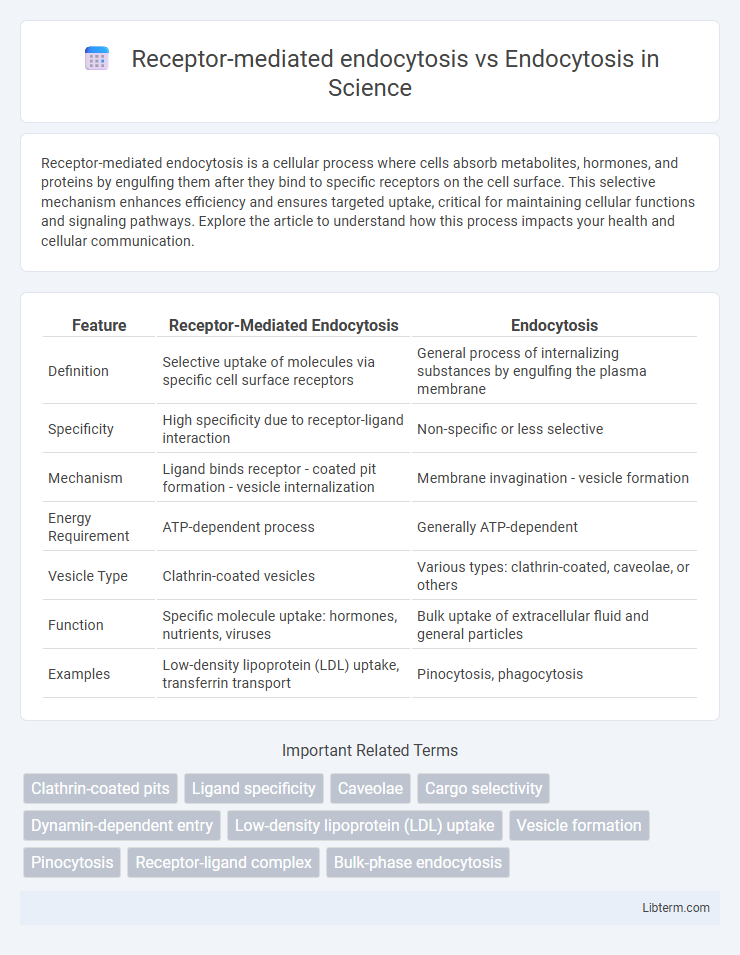Receptor-mediated endocytosis is a cellular process where cells absorb metabolites, hormones, and proteins by engulfing them after they bind to specific receptors on the cell surface. This selective mechanism enhances efficiency and ensures targeted uptake, critical for maintaining cellular functions and signaling pathways. Explore the article to understand how this process impacts your health and cellular communication.
Table of Comparison
| Feature | Receptor-Mediated Endocytosis | Endocytosis |
|---|---|---|
| Definition | Selective uptake of molecules via specific cell surface receptors | General process of internalizing substances by engulfing the plasma membrane |
| Specificity | High specificity due to receptor-ligand interaction | Non-specific or less selective |
| Mechanism | Ligand binds receptor - coated pit formation - vesicle internalization | Membrane invagination - vesicle formation |
| Energy Requirement | ATP-dependent process | Generally ATP-dependent |
| Vesicle Type | Clathrin-coated vesicles | Various types: clathrin-coated, caveolae, or others |
| Function | Specific molecule uptake: hormones, nutrients, viruses | Bulk uptake of extracellular fluid and general particles |
| Examples | Low-density lipoprotein (LDL) uptake, transferrin transport | Pinocytosis, phagocytosis |
Introduction to Endocytosis
Endocytosis is a cellular process where cells engulf external substances by engulfing them in a vesicle formed from the plasma membrane. Receptor-mediated endocytosis is a highly selective type of endocytosis in which specific molecules bind to receptors on the cell surface, triggering vesicle formation. This targeted mechanism allows cells to efficiently internalize essential nutrients, hormones, and other macromolecules.
Overview of Receptor-Mediated Endocytosis
Receptor-mediated endocytosis is a highly selective cellular process where specific ligands bind to membrane receptors, triggering vesicle formation for targeted internalization. This mechanism contrasts with general endocytosis by enhancing efficiency and specificity, crucial for nutrient uptake, signal transduction, and regulation of surface receptor levels. Key components include clathrin-coated pits, adaptor proteins, and receptor-ligand complexes, enabling precise control over substance entry into the cell.
Types of Endocytosis: Phagocytosis, Pinocytosis, and Receptor-Mediated
Endocytosis is a cellular process that involves the engulfing of external substances by the cell membrane, subdivided into phagocytosis, pinocytosis, and receptor-mediated endocytosis. Phagocytosis targets large particles like bacteria for degradation, often performed by macrophages, while pinocytosis involves nonspecific uptake of extracellular fluids and solutes. Receptor-mediated endocytosis is a highly selective mechanism where specific ligands bind to cell surface receptors, triggering vesicle formation and internalization, critical for nutrient uptake and signal transduction.
Molecular Mechanisms of Endocytosis
Receptor-mediated endocytosis is a highly selective process involving specific ligand-receptor interactions that trigger clathrin-coated pit formation on the plasma membrane, facilitating targeted internalization of molecules such as LDL or transferrin. In contrast, general endocytosis includes non-specific engulfment mechanisms like macropinocytosis and phagocytosis, where larger volumes or particles are internalized without receptor specificity. Key molecular components in receptor-mediated endocytosis include adaptin proteins, clathrin triskelions, and dynamin GTPase, which coordinate vesicle budding and scission, whereas non-receptor-mediated endocytosis relies more on actin cytoskeleton remodeling and membrane ruffling.
Specificity of Receptor-Mediated Endocytosis
Receptor-mediated endocytosis demonstrates high specificity by utilizing receptor proteins on the cell surface that bind exclusively to particular ligands, ensuring selective uptake of molecules such as hormones, nutrients, and antibodies. In contrast, general endocytosis involves non-specific engulfment of extracellular fluid and solutes, resulting in less targeted internalization. This specificity enables receptor-mediated endocytosis to regulate cellular intake precisely and maintain homeostasis by controlling the type and amount of substances entering the cell.
Cellular Functions and Biological Significance
Receptor-mediated endocytosis selectively internalizes specific molecules through receptor-ligand interactions, enhancing cellular uptake of nutrients, hormones, and signaling molecules essential for maintaining cellular homeostasis and communication. This mechanism ensures precise regulation of cellular functions such as nutrient acquisition, membrane recycling, and signal transduction, contributing to cellular adaptation and survival. In contrast, general endocytosis encompasses non-specific engulfment processes, playing a broader role in membrane turnover and bulk material uptake, but lacking the specificity and regulatory capacity critical for fine-tuned cellular responses.
Major Differences Between Receptor-Mediated and General Endocytosis
Receptor-mediated endocytosis is a highly selective process where specific ligands bind to cell surface receptors, triggering vesicle formation, whereas general endocytosis (or pinocytosis) involves non-specific engulfment of extracellular fluid and molecules. The former enables targeted internalization of essential biomolecules like cholesterol and hormones via coated pits, often clathrin-coated, while the latter serves broader nutrient uptake and membrane turnover functions. Receptor-mediated endocytosis exhibits saturation kinetics due to receptor availability, contrasting with the continuous and non-specific nature of general endocytosis.
Examples of Receptor-Mediated Endocytosis in Cells
Receptor-mediated endocytosis is a highly selective cellular process in which specific ligands bind to cell surface receptors, triggering the internalization of the receptor-ligand complex into clathrin-coated vesicles. Examples include the uptake of low-density lipoprotein (LDL) via LDL receptors for cholesterol regulation, transferrin bound to transferrin receptors for iron transport, and insulin receptor-mediated internalization to modulate glucose uptake. This specificity contrasts with general endocytosis, which engulfs extracellular fluid and solutes nonspecifically through mechanisms like pinocytosis or phagocytosis.
Clinical and Biomedical Implications
Receptor-mediated endocytosis selectively internalizes ligands such as hormones, nutrients, and pathogens, enabling targeted drug delivery and gene therapy applications by exploiting specific cell surface receptors. In contrast, general endocytosis lacks this specificity, often resulting in less efficient uptake of therapeutic agents, which limits its clinical utility. Understanding the molecular mechanisms of receptor-mediated endocytosis enhances the development of precision medicine approaches and novel treatments for diseases like cancer, neurodegenerative disorders, and infectious diseases.
Summary and Future Perspectives
Receptor-mediated endocytosis is a highly selective cellular process that enables the internalization of specific molecules through ligand-receptor interactions, distinguishing it from general endocytosis which involves non-specific uptake of extracellular materials. This specificity facilitates targeted drug delivery and nutrient absorption, making it a critical mechanism in cellular communication and homeostasis. Future research is expected to enhance understanding of receptor dynamics and signaling pathways, enabling the development of advanced therapeutics and nanocarrier systems with improved targeting efficiency and minimal off-target effects.
Receptor-mediated endocytosis Infographic

 libterm.com
libterm.com